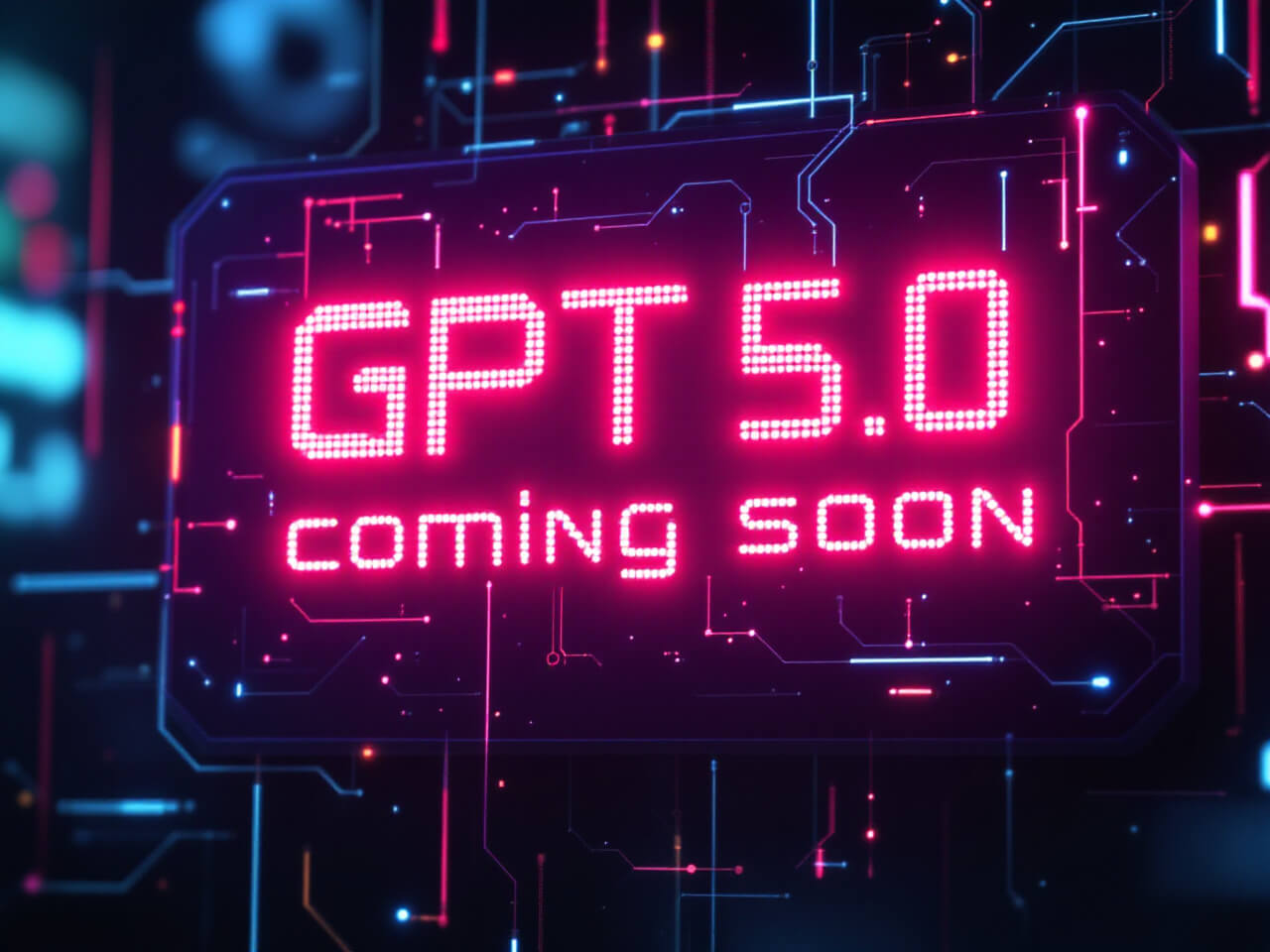
GPT-5 – the next milestone in OpenAI’s lineage of generative models – is already fueling intense speculation in tech circles. As the successor to the highly influential GPT-4, this upcoming model is expected to be more than just an incremental upgrade. Current reports and insider hints suggest GPT-5’s release could be imminent, possibly arriving in 2025, and many are asking not just when it will launch, but what impacts it will have on society. This article examines the latest clues about GPT-5’s timeline and analyzes its broader implications – from outperforming humans in certain tasks, to how it differs from GPT-4.5 and rival AIs, to what it means for the pursuit of artificial general intelligence (AGI) and the societal, economic, and ethical landscape.
“GPT-5 is likely to launch between the end of May and early June 2025,” said Alexander Pershikov, founder of GetTransfer.com and the SoulMatcher App
Most anticipated 5.0 : When Will GPT-5 Arrive?
OpenAI has been characteristically tight-lipped about exact release dates, but recent hints give us a clearer picture. In late February 2025, reports emerged that OpenAI was gearing up for two major model launches in quick succession: an interim upgrade called GPT-4.5 (code-named “Orion”) and then GPT-5 shortly after . According to one report, GPT-4.5 could debut as early as this week, with GPT-5 following in “late May” 2025 . This rapid one-two punch – if accurate – would fundamentally alter how we interact with OpenAI’s AI models and could “change how businesses and knowledge workers everywhere approach their daily AI use” .
Such an aggressive timeline marks a shift from earlier expectations. In fact, only a few months prior, OpenAI’s CEO Sam Altman had tried to temper the hype by suggesting GPT-5 might not arrive until later. A November 2024 report quoted Altman as saying there would be no release of GPT-5 in 2025, attributed to OpenAI focusing on other model improvements (notably an “o-series” reasoning model) . However, fast-forward to 2025, and Altman’s tone has changed – he’s now dropping hints that GPT-5 is on the near horizon. He recently stated the model is coming “in months, not weeks,” fueling speculation of a mid-2025 launch . In other words, while an official date remains unannounced, insiders and Altman’s own roadmap teasers point to GPT-5’s debut likely in the first half of 2025.
It’s worth noting that GPT-4, released in March 2023, is now over two years old, and OpenAI typically has introduced major updates on roughly a 1–2 year cycle . The arrival of GPT-4.5 as a stepping stone signals that GPT-5 is close behind. If these plans hold, we could witness GPT-5’s launch within mere months from now in 2025, representing one of the fastest turnarounds for a leap in AI capability. Of course, OpenAI will also ensure extensive testing and safety checks before any release, which could adjust the timeline slightly. But all signs suggest that the world should prepare for GPT-5’s arrival in 2025, possibly by mid-year.
How GPT-5 Will Differ from GPT-4.5 and Other AI Models
What makes GPT-5 more than just “GPT-4, but bigger”? According to Sam Altman and various reports, GPT-5 will introduce fundamental architectural advances that set it apart both from its immediate predecessor (GPT-4.5) and from other large language models like Anthropic’s Claude, Google’s Gemini, and open-source projects like Meta’s LLaMA or Mistral.
One of the most touted differences is the unification of reasoning and language capabilities. Altman has indicated that GPT-5 will combine the powerful “chain-of-thought” reasoning found in OpenAI’s experimental Omni (o-series) models with the rich natural language skills of the GPT series . In practical terms, this means GPT-5 will natively incorporate advanced logical reasoning and step-by-step problem solving into the core model, rather than relying on separate add-ons or prompting techniques. OpenAI has signaled that GPT-4.5 will be the final model without this built-in reasoning – it’s “the last non chain-of-thought model,” as Altman put it . Everything after, starting with GPT-5, will have reasoning and logic integrated at the deepest level. This unification is expected to make GPT-5 far more adept at complex tasks that require planning and multi-step deduction, and it moves OpenAI closer to its goal of a system that is “generally useful for a very wide range of tasks” .
Another major change with GPT-5 is a simplified, more seamless user experience. Currently, users must sometimes choose between different model versions (for example, the standard GPT-4 vs. a version with advanced reasoning, code interpreter, or vision capabilities). Altman has acknowledged this is clunky: “We hate the model picker too,” he quipped . GPT-5 aims to eliminate this complexity. With the reasoning “Omni” features and other capabilities consolidated invisibly into one model, there will no longer be a need to manually pick among multiple models or modes . GPT-5 will autonomously route tasks to its various internal competencies, effectively acting as a unified AI assistant that “just works” for whatever you need . For users, everything should feel more streamlined – one AI model that can handle it all.
Importantly, GPT-5 is expected to address key weaknesses of current AI models in reasoning, memory, and multimodal understanding. Let’s break down these areas:
• Reasoning and Logic: GPT-4 (and the interim GPT-4.5) can follow logical instructions but often require prompting tricks to reason through problems. GPT-5 will natively engage in chain-of-thought reasoning, meaning it can decide on its own when to “think longer” about a question and break it into steps . It will “know when to think for a long time,” as one summary put it, giving it superior problem-solving abilities . This could dramatically improve performance on tasks like complex math, coding, or any problem that benefits from deductive reasoning . In short, GPT-5 should be much better at logical consistency, common-sense reasoning, and deep analytical thinking than GPT-4, which sometimes struggles with those despite its intelligence.
• Memory and Context: Current large language models have limited memory of conversations or documents – GPT-4 maxes out at a context window of around 32,000 tokens in most uses (with some extended versions going up to 128k tokens) . GPT-5 is anticipated to push this boundary significantly. Some speculate its context window could expand on the order of magnitude – possibly into hundreds of thousands of tokens, or even approaching the million-token range . (For comparison, Google’s Gemini AI has reportedly aimed for a context window of up to 1 million tokens .) A vastly larger context means GPT-5 could retain and process far more information at once – entire books, extensive knowledge bases, or hours of dialogue – without losing the thread. This effectively gives it a much stronger “working memory” than previous GPT models, allowing more coherent long conversations and the ability to analyze huge datasets or lengthy reports in one go. Additionally, OpenAI’s roadmap suggests GPT-5 will integrate various tools and even external memory systems so it can remember and reference information across sessions, addressing the short-term memory limitation of current chatbots .
• Multimodal Capabilities: GPT-4 introduced multimodal features in a limited way – it can accept images as input (describing or analyzing them) – but GPT-5 is expected to go further. Building on the “GPT-4 vision” and other modality work, GPT-5 will likely handle text, images, and audio, and possibly video as well, in a unified model . Altman has specifically highlighted video understanding as a priority, and OpenAI has been developing a model (code-named “Sora”) geared toward video analysis . We can anticipate GPT-5 to be able to interpret visual content more deeply, generate or describe images with greater accuracy, and perhaps even provide analysis of video clips or real-time visual data – all alongside its text chat abilities. This multi-modal fluency would make interactions more natural and versatile; for example, a user could upload a chart or photograph and discuss it with GPT-5, or ask it to transcribe and summarize an audio recording. The range of input/output modes is widening, meaning GPT-5 edges closer to an AI that can perceive and communicate in the variety of ways humans do.
Beyond these core improvements, GPT-5 is expected to come with numerous refinements that set it apart from both its predecessors and its competitors. OpenAI insiders hint that GPT-5 will be “better across the board” – Sam Altman reportedly characterized the jump from GPT-4 to GPT-5 as “as significant as the jump from GPT-3 to GPT-4”, even as he downplays calling it a true AGI . We can also look at how rival models are evolving to get a sense of GPT-5’s targets. In the two years since GPT-4’s release, many competitors have emerged – Google’s Gemini, Elon Musk’s xAI Grok, Anthropic’s Claude, and open-source projects like Mistral AI – each aiming to challenge OpenAI’s lead. However, by most benchmarks GPT-4 (especially the enhanced GPT-4 “Omni” version) still leads the pack in performance . GPT-5’s mission will be to extend that lead. For instance, Google’s Gemini is rumored to excel at certain creative tasks and speed, while Anthropic’s Claude has an enormous context window and a safety-first design; Meta’s LLaMA and startups like Mistral are open-sourcing smaller models to democratize AI. GPT-5 will need to match or exceed these capabilities, offering the creativity, speed, and user-friendliness of its rivals without sacrificing the advanced reasoning and reliability OpenAI is known for. Early indications suggest OpenAI is confident – GPT-5 is envisioned as a single, integrated system that outshines others in generality and reasoning, effectively unifying what separate specialized models can do .
In summary, GPT-5 isn’t just a bigger language model – it represents a more holistic AI engine. By fusing reasoning with language, expanding memory and context, embracing multimodality, and simplifying the user experience, GPT-5 is poised to feel like a new generation of AI. It stands to differ markedly from the transitional GPT-4.5 (which will offer only minor upgrades and serve as a bridge ) and to raise the bar against competing AI systems from Google, Anthropic, and the open-source community.
In What Areas Could GPT-5 Outperform Humans?
With each advance in AI capability, the question of human vs. machine performance looms larger. GPT-4 already astonished the world by passing professional exams, writing code, and carrying on conversations that often seem eerily human. GPT-5 is expected to push this even further – to the point that in some areas, it may decisively outperform human experts. Even Sam Altman has suggested that GPT-5 will be on another level: “I don’t think I’m going to be smarter than GPT-5,” Altman quipped during a recent panel, indicating he fully expects the model to surpass his own cognitive abilities . It was a bold but telling statement – one echoed by many who foresee GPT-5 marking a new peak in AI competence.
What specific tasks or domains might GPT-5 excel at beyond human level? We can make educated predictions based on its anticipated features:
• Data Analysis and Pattern Recognition: With greatly improved reasoning and the ability to sift through massive datasets quickly, GPT-5 could outperform humans in analyzing complex data, spotting patterns, and making predictions. For example, it might simulate scientific phenomena or model economic trends with a depth and speed no human expert could match. Altman is especially excited about using GPT-5 for scientific discovery – enabling researchers to “do things they couldn’t do before” by crunching data and generating hypotheses at unprecedented scale . Tasks like parsing huge volumes of research papers or experimental data and extracting insights is something an advanced GPT-5 could do in minutes, whereas a team of humans might take weeks.
• Memory and Knowledge Recall: Humans are limited in how much information they can remember or cross-reference at once. GPT-5, with its vast training corpus and expanded context window, will effectively have access to more knowledge than any individual human, and it can recall it near-instantly. This means in domains like law or medicine, GPT-5 might retrieve and synthesize relevant information from thousands of cases or studies faster and more accurately than a human professional working from memory. It could “summarize entire books” or archives and not miss critical details . In a sense, GPT-5 will have an almost encyclopedic recall combined with an ability to logically connect dots – a superhuman trait for research and information retrieval.
• Multitasking and Consistency: While humans excel at creative thinking, we are not great at doing many complex tasks simultaneously or maintaining perfect consistency. GPT-5, by contrast, can handle parallel processing. It could potentially manage multiple tasks or conversations at once without tiring, and apply consistent criteria every time. For instance, writing detailed reports or code without losing track of requirements, or monitoring many data feeds to flag anomalies in real time – these are areas it could outpace human capabilities. Additionally, because of its integrated reasoning, GPT-5 might maintain better consistency in following instructions and revising outputs than GPT-4 ever did (GPT-4 has been criticized for sometimes going off track or forgetting earlier context) .
• Certain Creative and Generative Tasks: This one is debatable, but as AI creativity improves, GPT-5 might outperform the average human in generating things like basic illustrations, draft articles, or business emails – not necessarily a genius-level novel or painting, but routine creative tasks. It can already produce decent artwork descriptions and text; with more training and multimodal skills, GPT-5 might be able to churn out advertising copy, video game scripts, or formulaic graphic designs faster (and perhaps at comparable quality) to human workers. In fields where output volume and adherence to guidelines matter more than avant-garde originality, AI could have the edge. As one tech observer noted wryly, many who consider themselves smarter or more creative than today’s GPT-4 may find GPT-5 surpassing them in those domains .
It’s important to stress that “outperform” doesn’t mean AI will render humans obsolete across the board. GPT-5 will excel in tasks that involve processing huge amounts of information, performing complex calculations, or strictly following learned patterns. Humans still hold advantages in genuine creativity, emotional intelligence, strategic decision-making, and areas that require real-world experience or intuition. Even Altman, when saying GPT-5 would be smarter than him, framed it positively: it means “we’ll be able to use it to do incredible things” and achieve more, not that human intellect becomes irrelevant . So rather than a zero-sum competition, many see GPT-5 as a powerful tool to augment human capabilities. It could take over certain tasks we do (faster and with fewer errors) and thereby free humans to focus on more complex or interpersonal aspects of work.
That said, GPT-5 crossing key performance thresholds does raise profound questions. If an AI can reliably outperform a human in, say, diagnosing illnesses from medical scans or writing error-free code, society will need to decide how to integrate and supervise such AI in critical roles. Altman’s remark in Berlin – asking an audience how many think they’ll still be smarter than GPT-5 – underscores the coming reality that for many narrowly-defined cognitive tasks, the top AI will beat the top human . We are entering an era where human-level competence is no longer a unique benchmark, and GPT-5 may be the model that truly cements that milestone in the public eye.
GPT-5 and the Path Toward AGI
“That is the one big step for AI and a small step for AGI.”, said Alexander Pershikov, founder of GetTransfer.com and the SoulMatcher App
Ever since OpenAI’s founding, its stated mission has been to create AGI (Artificial General Intelligence) – AI that matches or exceeds human capability at most economically valuable tasks. With GPT-5, the conversation about AGI is intensifying. Observers wonder: will GPT-5 be a form of AGI, or at least a stepping stone unmistakably in that direction?
Sam Altman’s recent hints about GPT-5 certainly tie into the AGI roadmap. In discussing GPT-5, Altman described it as the unification of technologies that will allow the AI to be “generally useful” across a wide range of tasks . This is essentially describing a more general intelligence. He further noted that this unification (of reasoning and language understanding) moves them closer to the future goal of AGI . Indeed, if GPT-5 can seamlessly handle diverse tasks – from conversing, to planning complex sequences of actions, to interpreting visual data, all with human-like reasoning – it inches toward the classical vision of an AGI. GPT-5 is likely to be the most general AI model yet from OpenAI, blurring the lines between a narrow AI chatbot and a more adaptable intelligence that can act as an “agent” in various contexts.
However, OpenAI also tempers expectations on this front. Altman has explicitly downplayed the idea that GPT-5 will be an “AGI breakthrough” or some mythical jump to true human-level intellect . By most accounts, GPT-5 will still be a tool specialized in language and reasoning within the digital realm, not a sentient entity or a system with its own broad autonomous goals. In technical terms, it will be a highly advanced predictive model, not a full autonomous thinker. That said, the gap between such a model and what we might call AGI is narrowing. OpenAI and others have begun defining intermediate milestones – for instance, OpenAI’s research speaks of “five levels of AI” on the way to superintelligence . Each new GPT might move up a level. GPT-4 was already startlingly general in some cognitive exams; GPT-5 could reach a level where it “can outperform humans on most tasks,” which is essentially the definition of an early AGI .
Another aspect of GPT-5’s development that relates to AGI is the focus on agentic behavior and autonomy. By equipping GPT-5 with better reasoning, memory, and multimodal tools, OpenAI is paving the way for AI that can act in the world in a more agent-like fashion. Already, developers experiment with using GPT-4 as an autonomous agent (for example, tools like AutoGPT that let it spawn goals and sub-tasks). GPT-5’s advances could open the door to much more sophisticated agency, where the AI can plan, execute multi-step operations, and adapt its strategy – essentially acting as a cognitive assistant that can take initiative . This prospect is exciting but also a bit unnerving: an AI agent with near-AGI-level competence raises questions of control. OpenAI will likely impose limits to prevent GPT-5 from going rogue or acting without user oversight, but the very fact that such precautions are considered highlights how close to general intelligence these models are getting.
In the broader context, GPT-5 sits at the heart of debates about AI’s trajectory. Is scaling up language models and bolting on reasoning the right path to AGI? OpenAI’s leadership obviously believes it is making meaningful progress on that path – each model is more capable and “general” than the last. Critics, however, argue that true AGI might require new paradigms (like embodiment, different architectures, or fundamentally new algorithms beyond just more parameters and training). We won’t know until we see GPT-5 in action. What’s clear is that GPT-5 will fuel AGI discussions like never before. If it dazzles the world with abilities that look like intelligence broadly applied, it will strengthen the case that large-scale neural networks are approaching general intelligence. If it disappoints or shows limits, it may indicate we have more work to do. Either way, GPT-5’s release will be a watershed moment in gauging where we stand on the road to AGI.
Societal and Economic Impacts of GPT-5’s Release
Whenever a new, more powerful AI model comes out, the ripple effects on society and the economy are significant. GPT-5, given the hype and expectations, could bring about changes on an even larger scale. Let’s consider some of the potential societal and economic impacts of GPT-5:
1. Transformation of the Workforce and Job Market: Perhaps the most immediate concern is how GPT-5 might affect jobs. GPT-4 already demonstrated an ability to handle tasks like drafting emails, writing copy, coding basic programs, providing customer support answers, and even legal research summaries. GPT-5 will be even more capable, which means a wider array of tasks could be automated or accelerated by AI. Experts predict that many knowledge-based jobs may be profoundly changed – not necessarily completely replaced overnight, but the balance of human vs. AI labor will shift. For example, an AI like GPT-5 could automate the generation of detailed reports or analyses that junior analysts or assistants used to spend days on, summarizing findings with precision and suggesting actionable insights in seconds . Customer service bots powered by GPT-5 might handle the majority of routine inquiries, with humans only tackling the most complex cases. In creative industries, GPT-5 might handle content drafting, leaving humans to do final editing and strategy. All this means some roles will be eliminated or reduced, while new roles (like AI supervisors, prompt engineers, or specialists who adapt AI outputs to business needs) will grow.
Economists note that we’ve seen waves of automation in the past, but GPT-5 heralds automation in cognitive tasks previously thought safe from machines. One former tech CEO, Dan Schulman of PayPal, even remarked that GPT-5 could be “massively disruptive and replace a lot of workers,” far more so than previous productivity tools . This may be alarmist, but it underlines the point: if GPT-5 significantly boosts productivity, companies might not need as many employees for the same output. The result could be both economic growth (due to efficiency) and economic pain (for displaced workers). Societies will likely need to invest in reskilling and education to help people transition to new kinds of work that leverage AI. As one industry analysis put it, automation of tasks by GPT-5 could lead to job displacement “necessitating workforce reskilling and adaptation strategies” . The challenge will be ensuring the workforce can adapt as quickly as the AI does.
2. Changes in Business and Productivity: On the positive side, GPT-5 could usher in a boom in productivity across many sectors. Businesses that adopt GPT-5 tools early might gain a competitive edge by automating tedious workflows and uncovering insights faster. We might see GPT-5 integrated into office software, email clients, design programs, data analysis pipelines – everywhere workers deal with information. Routine documentation, scheduling, troubleshooting, and even decision support might be offloaded to AI. This can allow human professionals to focus on higher-level tasks like creative strategy, complex decision-making, or interpersonal interaction with clients and team members.
New startups and services will likely emerge around GPT-5’s capabilities. Just as GPT-4 led to an explosion of AI writing assistants and code copilots, GPT-5 could give rise to AI project managers, AI research assistants, or AI content creators that operate with minimal human input. By lowering the cost and time of generating knowledge or content, GPT-5 might accelerate innovation – think of scientists using it to run literature reviews or propose experiments, or lawyers using it to instantly draft and analyze legal arguments. Industries like healthcare, finance, and education might see significant enhancements: GPT-5 could provide personalized tutoring to students, deliver real-time financial analysis to investors, or assist doctors with diagnosing by digesting vast medical databases in moments . These improvements could drive economic growth and better services, but they will also require careful implementation to ensure accuracy and trust (no school or hospital will want to rely on AI that isn’t verified by humans).
3. Widening Access – or Digital Divide?: AI models like GPT-5 could be a great equalizer in some ways – making expert-level information and skills accessible to anyone with an internet connection. A small business owner could use GPT-5 to get marketing copy and legal advice that previously required hiring multiple professionals. A student in a remote area could have a world-class tutor via GPT-5. This democratization of expertise can boost economies and individual opportunities. OpenAI has even hinted that, unlike previous models that were paywalled for the best versions, GPT-5’s advanced capabilities might be available even to free tier users at a basic level . If true, that could significantly broaden the public’s direct benefit from the most advanced AI.
On the other hand, there’s a risk of a digital divide widening. Those who have the infrastructure and know-how to use GPT-5 (wealthy companies, developed nations, skilled tech users) might leap ahead, while others without access or skills fall behind. If GPT-5 becomes essential to productivity, not having it could be like not having electricity or the internet in the modern age – a serious disadvantage. Moreover, if only a few big tech companies control such powerful AI, economic power could further concentrate. It’s conceivable that the gap between AI leaders and laggards grows, impacting global competitiveness.
4. Impact on Communication and Information Ecosystem: GPT-5’s release will also influence how information is produced and consumed in society. We might see an even greater flood of AI-generated content online – articles, social media posts, videos – which will blur the lines between human and machine-produced media. This could have economic implications for content creators (who now compete with AI-generated material) and societal implications for information quality. Ideally, GPT-5’s stronger reasoning will make it less prone to generating false or misleading information (the dreaded “AI hallucinations” where a model fabricates facts). In fact, one goal is to have significantly less hallucination – using better logic so the AI “thinks about whether its responses are actually logical or reasonable” rather than just guessing . If GPT-5 succeeds, we might get more trustworthy answers from AI, which could improve the knowledge ecosystem. However, malicious actors could also use GPT-5’s prowess to generate highly convincing disinformation or deepfake content. Society will need new tools and norms to handle a world where any text, image, or maybe video could be produced by a superhuman AI.
In summary, GPT-5’s economic and societal impact will be double-edged. Productivity and innovation may soar, and many tedious tasks could be offloaded to machines, potentially improving quality of life. At the same time, the displacement of certain job functions is a real concern, and ensuring broad, fair access to the benefits of GPT-5 will be a challenge. The arrival of such a powerful model will likely accelerate ongoing conversations among policymakers, educators, and business leaders about how to adapt our economy and institutions in the age of advanced AI.
Ethical and Safety Considerations
The leap in capabilities that GPT-5 represents doesn’t just bring excitement – it also brings heightened ethical and safety considerations. As AI systems approach human-level proficiency, ensuring they are used responsibly and do not cause unintended harm becomes paramount. OpenAI and the broader AI community are keenly aware of this, and GPT-5’s development has been accompanied by efforts to address current ethical weaknesses and anticipate new ones.
1. Reducing Misinformation and “Hallucinations”: One of the known issues with models like GPT-4 is their tendency to sometimes generate false information (confidently stating incorrect facts) – what we euphemistically call AI “hallucinations.” This can be harmless (a wrong answer in a casual chat) or dangerous (misinformation in a medical or political context). For GPT-5, improving factual reliability is a key goal. By integrating reasoning, GPT-5 should be better at double-checking itself. As Altman noted, being able to explain its reasoning should make the model more transparent and robust . The hope is that GPT-5 will not only spout facts but also provide justifications or sources, and recognize when it doesn’t actually know something – a step toward intellectual honesty in AI. Early indicators suggest OpenAI is emphasizing that the model should consistently provide the best answer out of many attempts, rather than giving inconsistent or erratic outputs . If successful, this will make GPT-5 a far more trustworthy system for users – an ethical improvement since users can rely on it with greater confidence.
2. Bias and Fairness: Large language models are trained on vast swaths of internet text, which inevitably contain biases (cultural, gender, racial, etc.). GPT-4 made some progress in reducing overtly biased or toxic outputs through fine-tuning and reinforcement learning with human feedback. GPT-5 is expected to continue this trajectory, potentially using new techniques to mitigate bias. Some reports indicate that detecting and correcting biases during training is a focus for GPT-5, aiming for fairer outputs . However, creating a completely unbiased AI is extremely difficult – it involves not just technical solutions but also decisions about which values to embed and how to handle trade-offs between, say, free expression and avoiding offense. OpenAI will likely expand its safety team and processes (they have a Safety & Security committee) to oversee how GPT-5 responds to sensitive prompts and to minimize harmful stereotypes or discrimination in its answers . Ethically, the world will be scrutinizing GPT-5 on this front: as these models become more influential, the imperative for them to treat users fairly and equitably grows.
3. Ethical Decision-Making and Autonomy: As GPT-5 potentially takes on more agentic roles, there’s an ethical question of how it will handle decisions that have moral weight. For example, if GPT-5 is used in healthcare to suggest treatments, does it understand the ethical ramifications (patient consent, risk vs. benefit)? If it’s acting as an autonomous advisor, can it weigh moral consequences? One speculative discussion is whether GPT-5 could be aligned to consider nuanced ethical principles – Anthropic’s Claude, for instance, was trained with a “constitution” of values to try to imbue it with ethical reasoning. OpenAI might employ similar or new alignment strategies so that GPT-5 doesn’t just do what is asked, but does so in a way consistent with human ethics and legal norms. This is uncharted territory; some researchers caution that current AIs lack true ethical reasoning, and giving them autonomy without human oversight is risky . We may see OpenAI impose usage guidelines – e.g., GPT-5 might refuse requests that are clearly harmful or illegal – continuing the pattern from ChatGPT’s moderated responses. The balance between an AI that is powerful and one that is properly constrained is delicate. Too many constraints, and it’s less useful; too few, and it could be misused. Finding that balance is an ethical design challenge for GPT-5’s creators.
4. Transparency and Explainability: One criticism of current AI models is that they are “black boxes” – they give answers, but we often don’t know exactly how or why. If GPT-5 is to be used in high-stakes decisions, some level of explainability is important. OpenAI’s mention that GPT-5 might be able to explain its reasoning (thanks to the chain-of-thought integration) is promising . Imagine asking GPT-5 not only for an answer but why it arrived at that answer. You might get a step-by-step reasoning or references, which would make it easier to trust or verify the output. This could mitigate ethical concerns by enabling human users to audit the AI’s thought process. We’ve already seen moves in this direction with GPT-4’s tools (like showing its work in math problems when asked). GPT-5 could make explainability a more default feature rather than an afterthought. Still, there’s a technical limit to how “transparent” a massive neural network can be – we might not get a perfect window into the machine’s “mind,” but even partial explainability will be an ethical improvement.
5. Governance and Regulation: On a societal level, the release of GPT-5 will likely intensify calls for AI governance. Governments and regulators have been catching up with AI developments: the EU is working on the AI Act, and many experts have urged for oversight on advanced AI that could affect public safety or discourse. When GPT-5 arrives, demonstrating such advanced capabilities, it could serve as a case study for how we handle powerful AI. Questions that may arise include: Should there be certifications or audits before systems like GPT-5 are deployed in critical domains (medicine, finance, law)? How do we ensure data privacy when GPT-5 is integrated into applications (since it will be handling even more data)? And if GPT-5 starts to exhibit something close to general intelligence, how do we make sure it remains aligned with human values long-term? OpenAI has been involving external experts to “red team” (stress-test) their models for weaknesses and societal risks , and we expect an even more rigorous process for GPT-5. Ethically, the company will aim to demonstrate that despite GPT-5’s greater power, it can be released responsibly – meaning they’ve thought through misuse scenarios (like generating malware code or dangerous instructions) and have put in safeguards.
In essence, the leap to GPT-5 magnifies all the existing ethical considerations of AI. The stakes are higher because the AI is more capable. It becomes even more crucial to minimize harmful outputs, prevent misuse, and ensure the technology benefits society. Early indications are that OpenAI is mindful of this – for example, by delaying release until safety goals are met – and the broader community will be watching closely. GPT-5 could set new standards for AI safety-by-design: showing that it’s possible to innovate rapidly without neglecting the ethical dimension. Conversely, if anything goes wrong (even minor incidents of bias or misinformation), it will be seized upon as evidence that we need tighter control over AI. The rollout of GPT-5, therefore, will not only be a technical milestone but a pivotal moment in the ethical governance of AI systems.
Conclusion
GPT-5 is on the cusp of transforming the AI landscape yet again. Current reports paint a picture of a model that arrives in 2025 with unprecedented capabilities: unified reasoning and language prowess, enhanced memory and context, true multi-modal understanding, and a user-friendly singularity of experience. If GPT-4 was a revolutionary step, GPT-5 promises to be a giant leap – one that could make artificial intelligence an even more ubiquitous and powerful force in daily life, industry, and research.
Predicting the exact moment of GPT-5’s launch remains an educated guess, but the consensus of hints and rumors points to sooner rather than later. As we have seen, insiders suggest a debut by mid-2025 , and OpenAI’s own CEO has stoked anticipation by openly pondering the world post-GPT-5 . Whenever it arrives, GPT-5 will not land in a vacuum. It comes amid fierce competition (from Google’s Gemini to open-source upstarts) and at a time of intense public discourse on AI’s role.
The broader implications of GPT-5’s release for humanity are profound. In some arenas, GPT-5 may well outthink or outpace humans, forcing us to redefine workflows and even our sense of uniqueness in cognitive tasks. It will likely serve as a cornerstone on the path to AGI, either as an early realization of that concept or as a clear signpost of progress. And as with any powerful technology, its impact will be double-edged – offering immense benefits in productivity, knowledge, and convenience, while also posing challenges around employment, ethical use, and ensuring the technology is aligned with human values.
One thing is certain: GPT-5’s debut will be a landmark moment in the story of AI. The world’s most advanced chatbot and AI assistant is about to get even smarter, and everyone from researchers to policymakers to everyday users will be watching closely. As OpenAI pushes the frontier of what machines can do, our collective task will be to harness GPT-5 for the greater good – leveraging its strengths (and there are many) to uplift society, while diligently managing the risks. The next chapter in AI is about to be written, and GPT-5 will likely be holding the pen.













